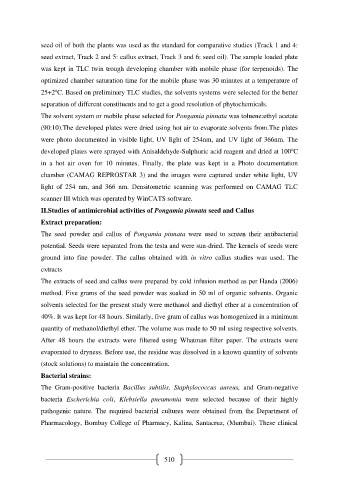Page 520 - e-Book
P. 520
seed oil of both the plants was used as the standard for comparative studies (Track 1 and 4:
seed extract, Track 2 and 5: callus extract, Track 3 and 6: seed oil). The sample loaded plate
was kept in TLC twin trough developing chamber with mobile phase (for terpenoids). The
optimized chamber saturation time for the mobile phase was 30 minutes at a temperature of
o
25+2 C. Based on preliminary TLC studies, the solvents systems were selected for the better
separation of different constituents and to get a good resolution of phytochemicals.
The solvent system or mobile phase selected for Pongamia pinnata was toluene:ethyl acetate
(90:10).The developed plates were dried using hot air to evaporate solvents from.The plates
were photo documented in visible light, UV light of 254nm, and UV light of 366nm. The
o
developed plates were sprayed with Anisaldehyde-Sulphuric acid reagent and dried at 100 C
in a hot air oven for 10 minutes. Finally, the plate was kept in a Photo documentation
chamber (CAMAG REPROSTAR 3) and the images were captured under white light, UV
light of 254 nm, and 366 nm. Densitometric scanning was performed on CAMAG TLC
scanner III which was operated by WinCATS software.
II.Studies of antimicrobial activities of Pongamia pinnata seed and Callus
Extract preparation:
The seed powder and callus of Pongamia pinnata were used to screen their antibacterial
potential. Seeds were separated from the testa and were sun-dried. The kernels of seeds were
ground into fine powder. The callus obtained with in vitro callus studies was used. The
extracts
The extracts of seed and callus were prepared by cold infusion method as per Handa (2006)
method. Five grams of the seed powder was soaked in 50 ml of organic solvents. Organic
solvents selected for the present study were methanol and diethyl ether at a concentration of
40%. It was kept for 48 hours. Similarly, five gram of callus was homogenized in a minimum
quantity of methanol/diethyl ether. The volume was made to 50 ml using respective solvents.
After 48 hours the extracts were filtered using Whatman filter paper. The extracts were
evaporated to dryness. Before use, the residue was dissolved in a known quantity of solvents
(stock solutions) to maintain the concentration.
Bacterial strains:
The Gram-positive bacteria Bacillus subtilis, Staphylococcus aureus, and Gram-negative
bacteria Escherichia coli, Klebsiella pneumonia were selected because of their highly
pathogenic nature. The required bacterial cultures were obtained from the Department of
Pharmacology, Bombay College of Pharmacy, Kalina, Santacruz, (Mumbai). These clinical
510

